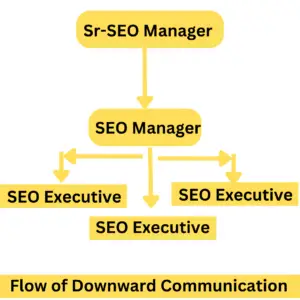What Is Downward Communication?
Downward Communication is a vertical type of communication that flows from a higher level of hierarchy to a lower one within any organization. The former group usually includes people in managerial or directorial roles, while the latter is composed of working employees.
For instance, managers explaining new goals, strategies, targets, etc. to employees at a lower level in a company’s hierarchy make use of the downward channel. Giving out deadlines, instructions, guidelines, feedback, and decisions also fall under the same category.
Downward communication does not necessarily have to take place verbally or face-to-face. It can happen in the form of written contracts, emails, letters, and invitations as well.
Must Read: To know more check out our detailed guide on what is downward communication
Advantages and Disadvantages of Downward Communication
While downward communication is highly effective for delivering instructional messages and laying down guidelines, it has its downside. Given below are the merits and demerits of downward communication in detail.
Advantages of Downward Communication
1) Creates a disciplined and organized working space
One of the foremost merits of downward communication is that it promotes the participation of the entire workforce in an orderly and step-by-step manner. This helps the higher-level executives and managers to discipline the employees at the bottom, disseminate information in a structured way, and organize work activities.
2) Ensures proper communication of instructions and principles
With a chain of command established in an organization, managers can easily lay down core instructions, rules and regulations, principles, policies, and plans for lower-level employees.
For example, the executives can inform the managers of different departments about the updated set of company policies. These managers can further relay the message to the employees under them, thus ensuring the information reaches everyone efficiently.
3) Paves way for a decentralized organization
With the help of effective downward communication roles and duties can be productively decentralized by creating hierarchies within and outside various departments.
For instance, administrators can create departments within a company to distribute workload as per expertise — marketing, human resource, finance, and so on. The department heads can also form teams to group their respective employees on different projects and achieve absolute organization of their tasks.
4) Increases employee motivation and job satisfaction
One of the major benefits of downward communication is that the top-level leaders can pass down constructive suggestions and headways to the employees at lower levels in the hierarchy. This adds to the overall work quality of employees, motivating them and providing the utmost job satisfaction.
5) Helps maintain hierarchy
There’s no scope for bypassing information when there’s a set hierarchy like in downward communication. It’s the top advantage of a downward flow of communication as the employees of all levels are kept in the loop and informed systematically.
6) Explains complex procedures and concepts for better understanding
The core purpose of downward communication is to bridge the information gap and keeps the employees updated. The seniors can easily convey explanations and information to simplify difficult or incomprehensible concepts for the juniors.
7) Delegation of duties and authorities
The crucial advantage of downward communication in an organization is that the administration and management can delegate authority and instill a sense of responsibility within the lower-level employees. This helps the people at the higher level to focus on more important tasks and train the lower-level workers simultaneously.
Disadvantages of Downward Communication
1) Time-consuming
Although downward communication brings order to the work of any organization, however, the big disadvantage of downward communication in an organization is it’s usually time-consuming. Information delays and lags become common and might also introduce unnecessary confusion or misunderstandings.
2) Increased rate of under-communication and overcommunication
There’s a high chance of the employees, irrespective of the level, explaining either too little or more than necessary. This disrupts the main essence of the information and its correction further demands more time.
3) Lack of proper feedback
Solely sticking to downward communication crosses out effective feedback from the picture. The lower-level employees are unable to express their challenges, improvise and learn from their faults.
4) Loss of information
Adding numerous layers to any communication channel introduces the problem of losing, forgetting, or missing out on information — another reason for downward communication to be ineffective.
5) Distortion of information
Besides the loss of information, it can also get unnecessarily modified and impaired due to multiple levels of hierarchy participating in communicating a single message.
6) Failing labor-management relationships
Lack of flexibility in communication and over-enforcement of authority can lead to resentment, frustration, and demotivation among employees. Having no opportunity to be vocal about their interests and feeling worthless in decision-making procedures can eventually harm the labor-management relation.
7) Overall reduced efficiency
While hierarchy is the backbone here, it is also the biggest barrier to downward communication. Failed time management, loss or distortion of the original information, and dictatorship-like authority decrease the overall efficiency of a workplace.
Example of Downward Communication

Types of Downward Communication
Downward communication in the workplace may take place in oral (intercom calls, meetings, lectures) as well as written form (letters, notes, employee handbooks, short reports).
Some of the most commonly used types of downward communication are as follows:
1) Notices
Notices fall under the category of formal communication and target a specific group of people. A notice is pinned/stuck to a display board to announce the necessary information to the target group. Government notices usually appear in the newspapers.
Related Reading: Advantages And Disadvantages of Formal Communication With Examples
2) Memos
Compared to business letters, a memo or a memorandum is an informal form of communication. It is mostly used for sharing information internally within a business/organization or with peers working on the same project.
A memo includes brief and concise information and permanently records your communication.
Related Reading: Informal Business Report
3) Circulars
A circular target a wider population and plays a vital role in large organizations with hundreds of employees. Simple and easily comprehensible in language, circulars are short, to the point, and have unique identification numbers (or circular numbers).
4) Newsletter
Newsletters are reports that are sent to employees periodically including details about recent and upcoming events, educational content, and updates. The readers’ interest is the core of an employee newsletter and it’s shared internally within an organization, irrespective of the department.
Why Is Downward Communication Important?
Downward communication is crucial to any organization with the hierarchy to ensure the proper functioning of the business as well as maintain consistency internally.
1) Achieve company goals and objectives
Downward communication assists in passing down the new strategies, goals, and objectives of a company as the market changes. Adaptation is essential for any business to thrive and with downward communication, it’s easier to update everyone in the organization regarding the same.
For example, telling the subordinates about the latest competition in your field and asking them for suggestions/ideas to tackle it.
2) Give task directives
Often, employees are left to consult their peers and find out task-relation information on their own.
Downward communication establishes a systematic approach to giving out task directives to subordinates. It keeps them updated about their duties, explains basic and advanced level procedures, and corrects errors.
3) Socialization
Downward communication makes use of every position/role in a hierarchy and builds scope for communication between them. Hosting events, circulating employee-focused newsletters, and sending out invitations create a harmonious workplace.
Advantages and Disadvantages of Upward Communication
Contrary to downward communication, upward communication carries its flow from the employees to the managers and executives.
Below are the pros of upward communication:
1) Room for feedback and grievances
Upward communication begins at the lowest level of the organizational hierarchy and thus employees have a major say here. They can share their feedback with the seniors regarding their requirements, the company’s working, and its policies affecting them.
2) Exchange of suggestions and required improvements
Since employees at the bottom level are the front-line workers dealing directly with the customers, they’re aware of their changing needs. With upward communication, they can let the superiors know of the situation at the ground level and share their suggestions and necessary improvements.
Below are the cons of upward communication:
1) Distortion of Information
As simple upward communication sounds, it comes with its disadvantages too — the biggest being the “adverse effect”. The subordinates tend to think about the consequences of their communication with their superiors and how it might affect their working efficiency.
2) Hesitation and unwillingness to communicate
Lack of initiative among employees further continues the downside of upward communication. They might fear the managers not accepting their feedback, calling them out in front of everyone, and humiliation.
For more details check out our in-depth resource on the advantages and disadvantages of upward communication.
Advantages and Disadvantages of Horizontal Communication
While upward and downward communication is suited for formal situations, horizontal communication works well for formal as well as informal settings. Also known as lateral communication, it refers to sharing information between peers or same-level employees across departments.
Below are the pros of horizontal communication:
1) Increases coordination within an organization
When same-level employees interact, there’s a high chance of mutual understanding and coordination. Planning becomes easier, direct conversations take place, and the communication style is warmer.
2) Strengthens workplace relations
Collaboration between peers not only boosts the overall efficiency of a task, but it solidifies the bond between them and brings everyone closer. Jealousies, misunderstandings, misconceptions, and doubts go away when peers can connect and express themselves thoroughly.
Below are the cons of horizontal communication:
1) Decreases productivity of employees
Too much mingling with peers might hamper the productivity of employees and even stunt the organization’s growth. This is the reason why horizontal communication is also considered a “waste of time” by many.
2) Leads to unhealthy competition
While lateral communication brings the peers closer, it might also lead to ego clashes between them. The employees may want to lead their own territories without any intrusion and lateral communication will only end up angering the rivalries.
Frequently Asked Questions
Q1) What are the advantages and disadvantages of lateral communication?
Ans: Lateral communication offers a better information exchange between employees when compared to other forms like downward and upward communication. However, it can also make the peers more competitive than ever, thus building cracks between departments.
Q2) Which of the following is a disadvantage of downward communication?
Ans:
The biggest limitation of downward communication is its room for feedback. The subordinates are unable to share their opinions or contribute to the subjects being discussed. This might leave them demotivated and even spiteful.
Q3) What are the advantages and disadvantages of upward communication and downward communication?
Ans: Upward communication allows the bottom-level employees to partake in discussions and suggest amendments for the betterment of the organization. However, it’s difficult for employees to initiate this type of communication in the first place out of fear or hesitation towards their superiors.
Downward communication, on one hand, helps delegate authority to subordinates and instill a sense of responsibility within them. On the other hand, it might become too “bossy” or overbearing for the employees that they feel dominated, worthless, and demeaned.



